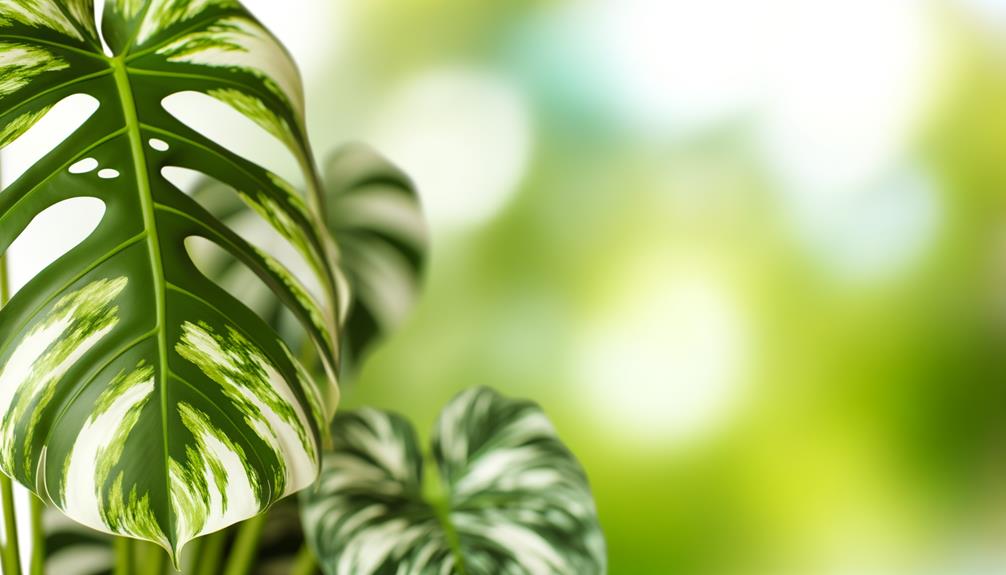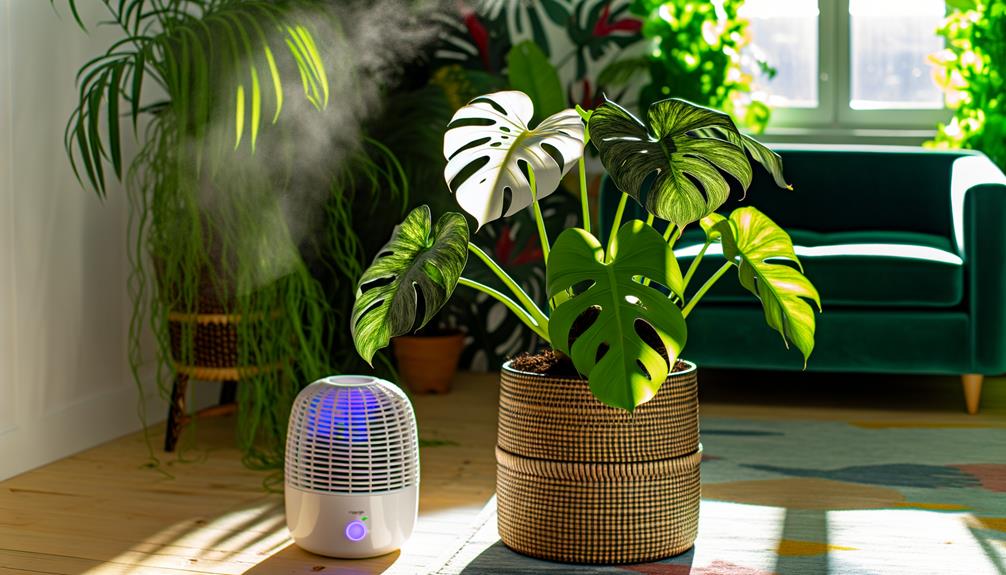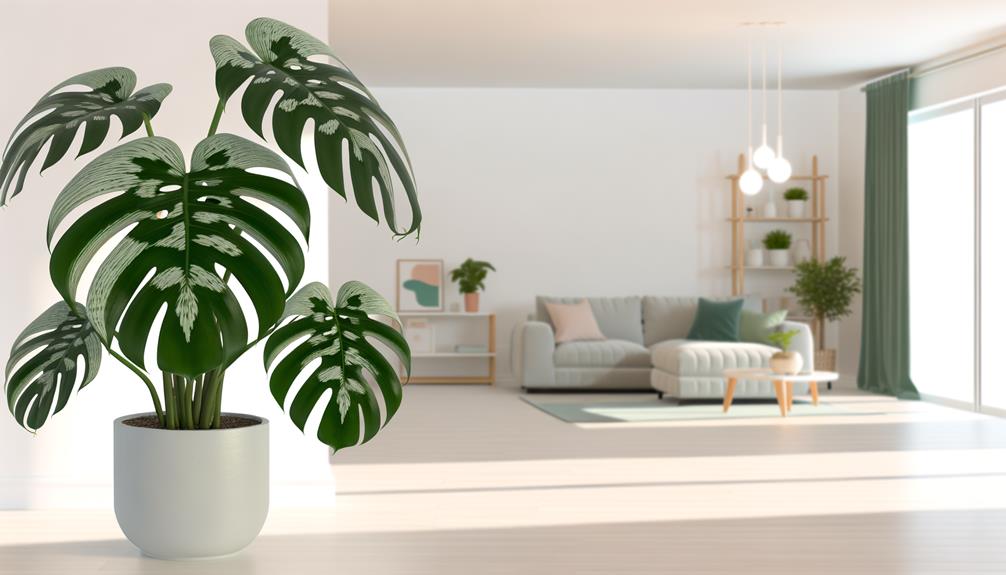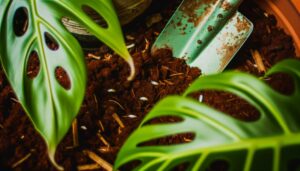What Is a Monstera Plant That Is White and Green? Identify!
You’re probably referring to the variegated Monstera deliciosa ‘Albo’. This plant features striking white patches on its deep green leaves, a result of genetic mutations affecting chlorophyll production.
These mutations create chimeric sections where white areas lack chlorophyll, producing the iconic variegation. Other types include Monstera deliciosa ‘Thai’ with marbled patterns and Monstera borsigiana ‘Albo’, known for faster growth.
Ideal growing conditions involve indirect sunlight, well-draining soil, and high humidity. Proper care includes consistent watering, bi-monthly fertilization, and pest monitoring.
This ornamental foliage garners high demand among plant enthusiasts. Learn more to maximize your plant care knowledge.

Key Takeaways
- Variegated Monstera plants have white and green leaves due to genetic mutations affecting chlorophyll production.
- Monstera deliciosa ‘Albo’ and Monstera borsigiana ‘Albo’ feature striking white patches on green leaves.
- Monstera deliciosa ‘Thai’ has speckled or marbled white and green leaf patterns.
- Variegated Monsteras are popular among plant enthusiasts for their unique ornamental foliage.
- Proper care includes indirect sunlight, well-draining soil, high humidity, and consistent watering.
Understanding Variegation

Understanding variegation in Monstera plants entails recognizing the genetic mutations that lead to the striking white and green patterns on their leaves. Variegation results from changes in chlorophyll production within the plant cells, specifically in the chloroplasts.
These mutations can be stable or unstable, affecting how the variegation appears on Monstera deliciosa or Monstera adansonii leaves. Typically, the white sections lack chlorophyll, reducing photosynthesis efficiency but creating visually appealing contrasts.
You’ll find that these genetic alterations are often recessive, meaning they’re not dominant traits. The variegated sections, termed ‘chimeric,’ consist of genetically different tissues.
Understanding this phenomenon allows you to appreciate the delicate balance between aesthetics and the plant’s overall health and growth.
Types of Variegated Monsteras
Recognizing the genetic basis of variegation allows us to categorize various types of variegated Monsteras, such as Monstera deliciosa ‘Albo-Variegata’ and Monstera deliciosa ‘Thai Constellation,’ each exhibiting distinct patterns and degrees of chlorophyll deficiency.
The ‘Albo-Variegata’ displays striking white patches against deep green leaves, while the ‘Thai Constellation’ features speckled or marbled patterns. Both fall under the family Araceae and genus Monstera.
| Type | Description |
|---|---|
| Monstera deliciosa ‘Albo’ | White patches, deep green leaves |
| Monstera deliciosa ‘Thai’ | Speckled/marbled patterns, stable variegation |
| Monstera adansonii ‘Var’ | Smaller leaves, white/cream variegation |
| Monstera borsigiana ‘Albo’ | Similar to ‘Albo’, but with smaller, faster growth |
| Monstera standleyana ‘Var’ | Elongated leaves, cream/white streaks |
Understanding these types helps you appreciate the diversity and uniqueness of variegated Monsteras.
Growing Conditions

Perfect growing conditions for variegated Monsteras necessitate a balance of indirect sunlight, well-draining soil, and consistent humidity levels to ensure healthy development and vibrant variegation. Monstera deliciosa, categorized under the family Araceae, thrives in environments that imitate its native tropical habitat.
Ensure you provide:
- Indirect Sunlight: Place your Monstera where it receives bright, filtered light to prevent leaf burn.
- Well-Draining Soil: Utilize a potting mix abundant in organic matter, ensuring good aeration and drainage.
- Humidity: Sustain humidity levels around 60-70% to replicate its tropical origin.
- Temperature: Maintain ambient temperatures between 65-85°F (18-29°C) for optimal growth.
- Watering: Water consistently, allowing the top inch of soil to dry out between watering to prevent root rot.
Care and Maintenance
To preserve the continued health and aesthetic appeal of your variegated Monstera, regular pruning, pest monitoring, and nutrient management are crucial.
Begin by pruning the Monstera deliciosa var. borsigiana to eliminate any dead or yellowing leaves, which preserves energy.
Examine leaves and stems for signs of pests like aphids, spider mites, or scale insects, and address infestations promptly using neem oil or insecticidal soap.
Variegated Monsteras require a balanced fertilizer, preferably a 20-20-20 N-P-K formulation, applied bi-monthly during the growing season.
Make sure you avoid overwatering by allowing the topsoil to dry out between waterings; this prevents root rot and sustains the plant’s vigor.
With attentive care, your Monstera will thrive, displaying its striking white and green foliage.
Popularity and Demand

The variegated Monstera deliciosa var. borsigiana has surged in popularity among indoor plant enthusiasts due to its unique white and green foliage and relative ease of care.
This cultivar, known for its striking variegation, exhibits a blend of chlorophyll-rich green and chlorophyll-deficient white sectors, making it highly sought after. Its demand is further amplified by its taxonomic classification within the Araceae family, which is renowned for ornamental foliage.
To help you appreciate this plant’s rise, consider the following:
- Aesthetic Appeal: Distinct white and green leaves.
- Rarity: Limited availability increases desirability.
- Versatility: Suitable for various indoor environments.
- Low Maintenance: Requires minimal care compared to other variegated species.
- Market Value: High resale value among collectors.
Understanding these factors can help you grasp why this Monstera is so coveted.
Conclusion
Coincidentally, as you explore the alluring world of variegated Monstera plants, you’ll discover Monstera deliciosa ‘Albo Variegata’ a stunning blend of white and green foliage.
This natural marvel not only demands specific growing conditions and meticulous care but also sparks immense interest among plant enthusiasts.
With its unique variegation caused by genetic mutations, owning one connects you to a vibrant community of botanists and collectors.
Embrace the challenge and beauty of nurturing this botanical masterpiece.






